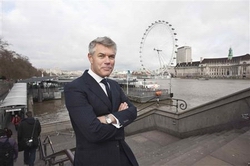 The company, market leader in precision measurement technology used in fields from microchip making to surveying dam construction, is now worth more than Swedish world number two white goods maker Electrolux after taking its business so far from its roots as to be unrecognizable.
The company, market leader in precision measurement technology used in fields from microchip making to surveying dam construction, is now worth more than Swedish world number two white goods maker Electrolux after taking its business so far from its roots as to be unrecognizable.When Ola Rollen stepped through the doors at Hexagon as CEO in 2000, leaving a job as head of a division at engineer Sandvik, he entered a company with lots of businesses but no business idea and scarcely any growth prospects.
Founded in 1975, Hexagon was then a sprawling conglomerate with its fingers in everything from tuna fish imports to vehicle hydraulics and, as financier Melker Schorling told Rollen at a meeting in downtown Stockholm in 1999, it was basically garbage.
Schorling had bought a controlling stake in the company the year before, aiming to build something from the ground up. Rollen, who first made a name for himself as a young CEO of metals firm Kanthal, had attracted his attention.
"He said: It can't get much worse. Build what you want," Rollen, now a trim and youthful 47, told Reuters from the company's Stockholm office of Scandinavian wood design, with large windows overlooking the capital.
Rollen had to think of ways to realign a company so diverse it came as a surprise when he found it ran day-care centers.
"We set up a number of criteria - that we would be world leading, that we would have large R&D content and little invested fixed assets - it should be easy to move the operations if there were shocks in the global economy," he said.
PATH TO LEADERSHIP
Focusing the business on telecommunications gear or vehicle components were among the options he was considering when he recalled U.S. measurement technology firm Brown & Sharpe, which had once sought to recruit him - an offer he turned down.
While Hexagon had no previous business in the field, the firm offered a possible path toward leadership in a fragmented market being reshaped by innovation in fields like lasers.
To free up resources, Hexagon began selling off assets in less promising sectors, starting with its food business that under previous management thinking was a buffer for the cyclical engineering business but which was barely profitable.
Brown & Sharpe was fortuitously in receivership at the time and though it was as big as Hexagon, Rollen bought it, taking the first step down a road that would see the firm acquire more than 100 companies and shed virtually all its original business.
"Very often I find company executives just have really poor imagination," Rollen said. "Just because you run a paper mill doesn't mean you have to keep on trudging on the same spot."
Hexagon's four biggest deals - Brown & Sharpe, Swiss Leica Geosystems, Canadian NovAtel and U.S. Intergraph - cost nearly $4 billion and group sales have more than quadrupled since 1999 to 2.38 billion euros ($3.08 billion).
In the same period its operating margin has risen to 20.6 percent from below 5 percent, underpinning a rise in market capitalization to 60 billion crowns ($9.28 billion) from just under 2 billion crowns. By comparison, the wider Swedish market index has gained 14 percent in that time.
Schorling owns Hexagon shares totaling 26.7 percent of capital and 47.7 percent of votes in the company, whose biggest owners also include H&M founding family member Stefan Persson.





